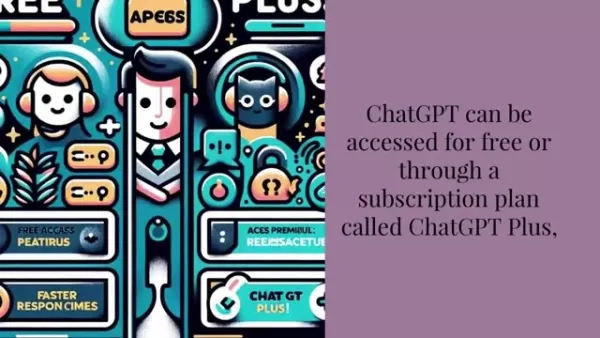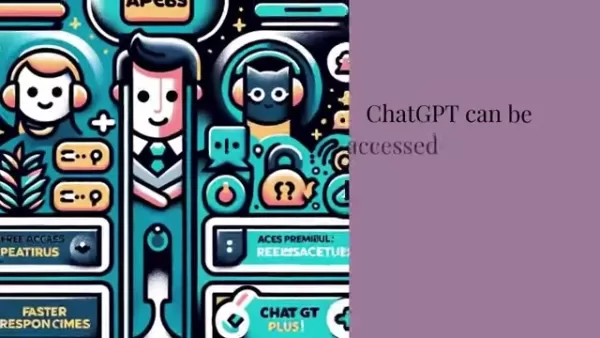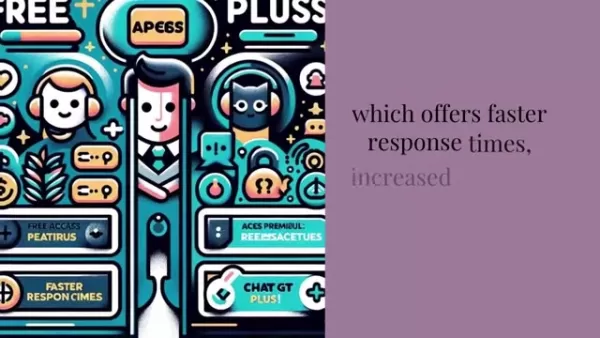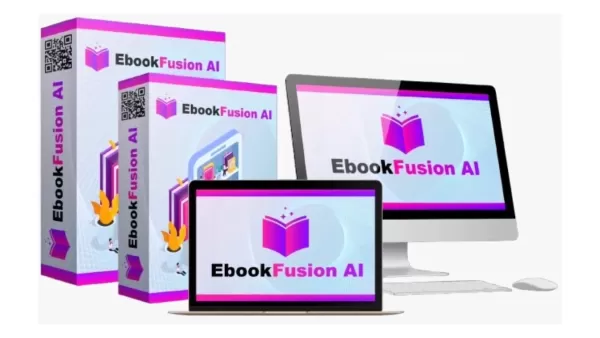ChatGPT Cheat Sheet 2024: Optimize AI Usage for Greatest Effect
ChatGPT: Revolutionizing Our Interaction with AI in 2024
As we navigate through 2024, ChatGPT continues to transform how we engage with artificial intelligence. This powerful tool from OpenAI has found its way into various sectors, enhancing productivity and sparking innovation. Whether you're new to AI or a seasoned user, understanding how to use ChatGPT effectively and ethically is essential. This comprehensive guide dives into the world of ChatGPT, from its basic structure to future possibilities, equipping you with the knowledge to maximize its potential while addressing ethical and security concerns.
Key Highlights
- ChatGPT, developed by OpenAI, is built on the GPT-4 architecture, a sophisticated language model.
- It predicts word sequences based on vast training data, allowing for natural text generation.
- Access to ChatGPT is available for free, with a subscription option (ChatGPT Plus) offering faster response times and additional features.
- Ethical use is crucial, including transparency about AI-generated content and respecting privacy.
- The future of ChatGPT in business looks bright, but it requires responsible handling.
- Competitors like Google's Gemini, Anthropic's Claude 3, and Microsoft's Copilot are shaping the AI chatbot landscape.
- Security issues, such as vulnerabilities and data extraction, require constant attention.
- OpenAI is continuously refining ChatGPT, enhancing its capabilities without immediate plans for a GPT-5 model.
Understanding ChatGPT: A Comprehensive Guide
What is ChatGPT?
ChatGPT is not just another software; it's a generative AI chatbot developed by OpenAI that excels in creating human-like text. It's a versatile tool that can answer questions, assist with writing tasks, and much more. Its utility spans from personal to professional applications, making it a game-changer in the AI world.

At the heart of ChatGPT lies the GPT-4 model, a large language model (LLM) designed to predict word sequences based on extensive training data. This enables it to generate coherent and contextually relevant text, essentially acting as an advanced autocomplete system that responds to complex prompts. Trained on a massive dataset that includes everything from books to online conversations, ChatGPT aims to make interactions as intuitive and natural as possible, bridging the gap between human language and machine understanding.
The development of ChatGPT marks a significant leap in AI technology, moving beyond simple rule-based systems to a more adaptable and intelligent assistant. It's a dynamic tool that evolves with each interaction, adapting to different styles and topics while maintaining a high level of coherence.
Key Features and Capabilities
- Natural Language Processing (NLP): ChatGPT leverages NLP to understand and respond to human language, ensuring interactions are both intuitive and contextually appropriate.
- Text Generation: From creative writing to technical documentation and code snippets, ChatGPT can generate a wide variety of content.
- Question Answering: It can answer a broad range of questions, drawing from its vast knowledge base to provide accurate and informative responses.
- Contextual Understanding: It remembers previous parts of a conversation, allowing for more coherent and relevant interactions over time.
These capabilities make ChatGPT an invaluable tool for enhancing productivity, creativity, and problem-solving across numerous applications.
ChatGPT vs. Competitors: A Side-by-Side Look
While ChatGPT leads the pack, understanding its competitors is crucial for a well-rounded view of the AI chatbot market.

Here's a quick rundown of key competitors:
- Google's Gemini (formerly Bard): A strong contender with deep integration into Google's ecosystem, offering real-time information and advanced analytics.
- Anthropic's Claude 3: Focused on safety and ethical considerations, it excels in handling complex, nuanced conversations.
- Microsoft's Copilot: Integrated into Windows and Microsoft 365, it enhances productivity and acts as a personal AI assistant.
- Meta AI with Llama 3: An open-source model aimed at customizable AI solutions, promoting transparency and community-driven development.
- Perplexity AI's Chatbot: Emphasizes accuracy and transparency, making it ideal for research and education.
Each competitor brings unique strengths to the table, and the choice depends on specific needs and preferences. For broad applicability and ease of use, ChatGPT remains a top choice, but for integration with existing ecosystems or a focus on ethical AI, alternatives might be more suitable.
Ethical Considerations and Security: Navigating AI Responsibly
As AI becomes more integrated into our lives, ethical considerations and security measures become paramount.

Responsible use of ChatGPT involves understanding potential risks and adhering to best practices:
- Transparency: Clearly mark AI-generated content to maintain trust and avoid misleading users.
- Privacy: Be aware of data privacy policies and protect personal information.
- Bias Mitigation: Evaluate training data to address potential biases in AI models.
- Accountability: Establish responsibility for AI actions and decisions.
- Security: Implement robust security measures to protect against cyber threats.
Addressing issues like vulnerabilities, misinformation, and bias requires ongoing vigilance and collaboration among AI providers, users, and policymakers. By following ethical guidelines and implementing security measures, we can harness AI's benefits while minimizing risks.
Unlocking ChatGPT's Full Potential: Advanced Tips and Strategies
Crafting Effective Prompts: The Secret to Quality Output
The quality of ChatGPT's output hinges on the prompts you provide. Here are some tips to get the best results:
- Be Specific: Clearly define what you need. Instead of "Write a story," say "Write a short story about a detective in 1920s New York."
- Provide Context: Give background information to help the AI understand the task. For example, "Write a blog post for marketing professionals about AI benefits for lead generation."
- Specify the Format: Clearly state the desired format, whether it's a list, poem, report, or code snippet.
- Use Keywords: Incorporate relevant keywords to guide the AI toward the desired topic and style, especially for SEO-focused content.
- Iterate and Refine: Experiment with different prompts and refine your requests based on the AI's output.
- Leverage Role-Playing: Assign roles to influence the tone and style of the output, such as "Write a product description as a seasoned marketer."
- Incorporate Constraints: Use constraints to stimulate creativity, like "Write a haiku about nature using only 17 syllables."
Mastering prompt engineering unlocks ChatGPT's full potential, allowing you to generate high-quality content tailored to your needs.
Fine-Tuning ChatGPT: Customizing AI for Your Needs
Fine-tuning allows you to train ChatGPT on custom datasets, enhancing its understanding and responses for specific topics or domains. Here's how to get started:
- Prepare a High-Quality Dataset: Ensure the data is clean, accurate, and representative of your target domain.
- Use OpenAI's API: Upload your dataset and configure fine-tuning parameters to optimize performance.
- Evaluate and Refine: Assess the AI's output and compare it before and after fine-tuning to measure improvement. Collect user feedback for further iterations.
Fine-tuning offers several benefits, including improved relevance, enhanced accuracy, personalized style, and domain expertise. Use cases include customer support, content creation, code generation, and data analysis. By fine-tuning ChatGPT, you can tailor the AI to your specific needs, unlocking new levels of productivity and innovation.
Getting Started with ChatGPT: A User-Friendly Guide
Accessing ChatGPT: Free vs. Subscription Options
ChatGPT offers both free and subscription-based access, catering to different user needs.

The free version provides basic functionality, suitable for casual users. However, it may experience slower response times and limited access during peak periods. ChatGPT Plus, at $20 per month, offers faster response times, priority access, and early access to new features, ideal for professionals and power users.
Access ChatGPT through a web browser, mobile apps, or integrate it into your applications using OpenAI's API. Choose the free version for basic AI assistance, ChatGPT Plus for enhanced capabilities, or the enterprise version for specific data privacy and compliance needs.
ChatGPT Pricing Plans: Choosing the Right Option
Understanding Costs and Benefits
ChatGPT offers different pricing options to suit various user needs.

- ChatGPT Free Plan: $0, with basic access to core functionalities. Ideal for casual users or those exploring AI without financial commitment.
- ChatGPT Plus Subscription: $20 per month, offering faster response times, priority access, and early access to new features. Suitable for power users and professionals.
- ChatGPT Enterprise Plan: Customized pricing based on organizational needs, with enhanced security controls and dedicated support. Tailored for businesses requiring high levels of data privacy and compliance.
The free version is perfect for individuals experimenting with AI or needing occasional assistance. ChatGPT Plus offers a significant upgrade for professionals, while the enterprise plan is designed for businesses with specific requirements.
ChatGPT Pros and Cons
Advantages
- Versatile AI chatbot with a broad range of applications
- Ability to generate human-like text
- Helpful in answering questions and supporting writing tasks
- Free and subscription-based access options
- Integration with various platforms via API
Disadvantages
- Potential to generate incorrect or biased information
- Limited knowledge of events after the last training update
- Potential for security vulnerabilities
- Ethical concerns regarding transparency and accountability
- Reliance on prompt engineering for optimal output
ChatGPT Core Features: Boosting Productivity with AI
Key Capabilities

ChatGPT's core features are designed to enhance productivity, creativity, and problem-solving:
- Text Generation: Useful for writing articles, blog posts, and product descriptions, with customizable tone and style.
- Question Answering: Provides accurate and informative responses to a wide range of questions.
- Code Generation: Assists developers with generating code snippets in various programming languages.
- Summarization: Extracts key points from lengthy texts, providing concise summaries.
- Translation: Translates text between multiple languages, facilitating cross-linguistic communication.
- Conversational AI: Engages in natural language conversations, useful for chatbots and virtual assistants.
- Role-Playing: Assumes different roles to customize tone, style, and perspective, aiding in diverse content creation.
These features make ChatGPT a powerful tool for driving innovation across industries.
ChatGPT Use Cases: Real-World Applications
How ChatGPT Can Be Used
ChatGPT's versatility has led to its adoption across various industries:
- Marketing and Content Creation: Generates articles, blog posts, and social media content, incorporating SEO principles.
- Customer Service: Powers chatbots to handle inquiries, provide support, and improve customer satisfaction.
- Education: Assists with research, writing assignments, and personalized learning experiences.
- Healthcare: Provides information, answers patient inquiries, and assists with medical research.
- Finance: Analyzes financial data, generates reports, and provides investment advice.
- Software Development: Helps with code generation, debugging, and documenting software projects.
By leveraging ChatGPT's capabilities, businesses and individuals can improve productivity, reduce costs, and drive innovation across their operations.
Frequently Asked Questions (FAQ)
What is the difference between ChatGPT and GPT-4?
ChatGPT is a conversational interface built on the GPT-4 language model. GPT-4 is the underlying AI model that generates text, while ChatGPT is the user-friendly interface for natural language conversations.
What are the limitations of ChatGPT?
ChatGPT's limitations include the potential to generate incorrect or biased information, limited knowledge of recent events, and potential security vulnerabilities. Users should be aware of these limitations and take steps to mitigate risks.
Is ChatGPT free to use?
ChatGPT offers both free and subscription-based access. The free version provides basic functionality, while ChatGPT Plus unlocks additional features and benefits.
Can ChatGPT replace human writers?
While ChatGPT can assist with writing tasks, it is unlikely to completely replace human writers due to the unique creativity and emotional intelligence humans bring to their work. ChatGPT enhances and augments human writing capabilities.
Is it ethical to use ChatGPT for content creation?
Using ChatGPT for content creation can be ethical if AI-generated content is clearly marked, and users are transparent about AI involvement. Ensuring accuracy, avoiding bias, and respecting copyrights are also important.
Related Questions
What are the potential impacts of AI on the labor market?
The widespread adoption of AI, including tools like ChatGPT, could have both positive and negative impacts on the labor market. AI can automate repetitive tasks, augment human capabilities, and drive productivity gains, but it could also displace workers, leading to job losses and income inequality. Navigating these impacts requires careful planning, worker retraining, and social safety nets to ensure fair and equitable outcomes for all workers.
Related article
 AI Vector Art in Illustrator Sparks Generative Design Revolution
AI-Powered Vector Art in Adobe IllustratorRevolutionizing Vector Design with Adobe Illustrator's AI IntegrationThe creative industry is undergoing a monumental shift with AI adoption, and Adobe Illustrator stands at the forefront of this transformati
AI Vector Art in Illustrator Sparks Generative Design Revolution
AI-Powered Vector Art in Adobe IllustratorRevolutionizing Vector Design with Adobe Illustrator's AI IntegrationThe creative industry is undergoing a monumental shift with AI adoption, and Adobe Illustrator stands at the forefront of this transformati
 EbookFusion AI: Revolutionize eBook Creation with Advanced AI Technology
In our digital-first era, eBooks have emerged as powerful tools for content distribution, lead generation, and thought leadership. While professional eBook production traditionally demands substantial time and expertise, EbookFusion AI transforms thi
EbookFusion AI: Revolutionize eBook Creation with Advanced AI Technology
In our digital-first era, eBooks have emerged as powerful tools for content distribution, lead generation, and thought leadership. While professional eBook production traditionally demands substantial time and expertise, EbookFusion AI transforms thi
 Microsoft's Next-Gen Xbox Features AMD Chip and Open Store Policy
Microsoft has officially unveiled its collaboration with AMD to develop next-generation Xbox hardware, signaling a bold new direction for its gaming ecosystem. Xbox President Sarah Bond revealed the partnership in a YouTube announcement, detailing pl
Comments (3)
0/200
Microsoft's Next-Gen Xbox Features AMD Chip and Open Store Policy
Microsoft has officially unveiled its collaboration with AMD to develop next-generation Xbox hardware, signaling a bold new direction for its gaming ecosystem. Xbox President Sarah Bond revealed the partnership in a YouTube announcement, detailing pl
Comments (3)
0/200
![JackPerez]() JackPerez
JackPerez
 August 23, 2025 at 9:01:18 AM EDT
August 23, 2025 at 9:01:18 AM EDT
ChatGPT's impact in 2024 is wild! It's like having a super-smart buddy for work and ideas. But, is it too good? Kinda worried about over-reliance. 😅


 0
0
![FrankBrown]() FrankBrown
FrankBrown
 August 14, 2025 at 3:01:00 PM EDT
August 14, 2025 at 3:01:00 PM EDT
ChatGPT's impact in 2024 is wild! It's like having a super-smart assistant for everything from work to creative projects. Curious how far it'll go next year? 😎


 0
0
![JuanThomas]() JuanThomas
JuanThomas
 July 22, 2025 at 3:39:52 AM EDT
July 22, 2025 at 3:39:52 AM EDT
This ChatGPT guide is super handy! 😎 It’s wild how AI’s changing everything in 2024. I’m curious, though—how do you guys use it for creative stuff like writing or art? Any cool tips?


 0
0
ChatGPT: Revolutionizing Our Interaction with AI in 2024
As we navigate through 2024, ChatGPT continues to transform how we engage with artificial intelligence. This powerful tool from OpenAI has found its way into various sectors, enhancing productivity and sparking innovation. Whether you're new to AI or a seasoned user, understanding how to use ChatGPT effectively and ethically is essential. This comprehensive guide dives into the world of ChatGPT, from its basic structure to future possibilities, equipping you with the knowledge to maximize its potential while addressing ethical and security concerns.
Key Highlights
- ChatGPT, developed by OpenAI, is built on the GPT-4 architecture, a sophisticated language model.
- It predicts word sequences based on vast training data, allowing for natural text generation.
- Access to ChatGPT is available for free, with a subscription option (ChatGPT Plus) offering faster response times and additional features.
- Ethical use is crucial, including transparency about AI-generated content and respecting privacy.
- The future of ChatGPT in business looks bright, but it requires responsible handling.
- Competitors like Google's Gemini, Anthropic's Claude 3, and Microsoft's Copilot are shaping the AI chatbot landscape.
- Security issues, such as vulnerabilities and data extraction, require constant attention.
- OpenAI is continuously refining ChatGPT, enhancing its capabilities without immediate plans for a GPT-5 model.
Understanding ChatGPT: A Comprehensive Guide
What is ChatGPT?
ChatGPT is not just another software; it's a generative AI chatbot developed by OpenAI that excels in creating human-like text. It's a versatile tool that can answer questions, assist with writing tasks, and much more. Its utility spans from personal to professional applications, making it a game-changer in the AI world.

At the heart of ChatGPT lies the GPT-4 model, a large language model (LLM) designed to predict word sequences based on extensive training data. This enables it to generate coherent and contextually relevant text, essentially acting as an advanced autocomplete system that responds to complex prompts. Trained on a massive dataset that includes everything from books to online conversations, ChatGPT aims to make interactions as intuitive and natural as possible, bridging the gap between human language and machine understanding.
The development of ChatGPT marks a significant leap in AI technology, moving beyond simple rule-based systems to a more adaptable and intelligent assistant. It's a dynamic tool that evolves with each interaction, adapting to different styles and topics while maintaining a high level of coherence.
Key Features and Capabilities
- Natural Language Processing (NLP): ChatGPT leverages NLP to understand and respond to human language, ensuring interactions are both intuitive and contextually appropriate.
- Text Generation: From creative writing to technical documentation and code snippets, ChatGPT can generate a wide variety of content.
- Question Answering: It can answer a broad range of questions, drawing from its vast knowledge base to provide accurate and informative responses.
- Contextual Understanding: It remembers previous parts of a conversation, allowing for more coherent and relevant interactions over time.
These capabilities make ChatGPT an invaluable tool for enhancing productivity, creativity, and problem-solving across numerous applications.
ChatGPT vs. Competitors: A Side-by-Side Look
While ChatGPT leads the pack, understanding its competitors is crucial for a well-rounded view of the AI chatbot market.

Here's a quick rundown of key competitors:
- Google's Gemini (formerly Bard): A strong contender with deep integration into Google's ecosystem, offering real-time information and advanced analytics.
- Anthropic's Claude 3: Focused on safety and ethical considerations, it excels in handling complex, nuanced conversations.
- Microsoft's Copilot: Integrated into Windows and Microsoft 365, it enhances productivity and acts as a personal AI assistant.
- Meta AI with Llama 3: An open-source model aimed at customizable AI solutions, promoting transparency and community-driven development.
- Perplexity AI's Chatbot: Emphasizes accuracy and transparency, making it ideal for research and education.
Each competitor brings unique strengths to the table, and the choice depends on specific needs and preferences. For broad applicability and ease of use, ChatGPT remains a top choice, but for integration with existing ecosystems or a focus on ethical AI, alternatives might be more suitable.
Ethical Considerations and Security: Navigating AI Responsibly
As AI becomes more integrated into our lives, ethical considerations and security measures become paramount.

Responsible use of ChatGPT involves understanding potential risks and adhering to best practices:
- Transparency: Clearly mark AI-generated content to maintain trust and avoid misleading users.
- Privacy: Be aware of data privacy policies and protect personal information.
- Bias Mitigation: Evaluate training data to address potential biases in AI models.
- Accountability: Establish responsibility for AI actions and decisions.
- Security: Implement robust security measures to protect against cyber threats.
Addressing issues like vulnerabilities, misinformation, and bias requires ongoing vigilance and collaboration among AI providers, users, and policymakers. By following ethical guidelines and implementing security measures, we can harness AI's benefits while minimizing risks.
Unlocking ChatGPT's Full Potential: Advanced Tips and Strategies
Crafting Effective Prompts: The Secret to Quality Output
The quality of ChatGPT's output hinges on the prompts you provide. Here are some tips to get the best results:
- Be Specific: Clearly define what you need. Instead of "Write a story," say "Write a short story about a detective in 1920s New York."
- Provide Context: Give background information to help the AI understand the task. For example, "Write a blog post for marketing professionals about AI benefits for lead generation."
- Specify the Format: Clearly state the desired format, whether it's a list, poem, report, or code snippet.
- Use Keywords: Incorporate relevant keywords to guide the AI toward the desired topic and style, especially for SEO-focused content.
- Iterate and Refine: Experiment with different prompts and refine your requests based on the AI's output.
- Leverage Role-Playing: Assign roles to influence the tone and style of the output, such as "Write a product description as a seasoned marketer."
- Incorporate Constraints: Use constraints to stimulate creativity, like "Write a haiku about nature using only 17 syllables."
Mastering prompt engineering unlocks ChatGPT's full potential, allowing you to generate high-quality content tailored to your needs.
Fine-Tuning ChatGPT: Customizing AI for Your Needs
Fine-tuning allows you to train ChatGPT on custom datasets, enhancing its understanding and responses for specific topics or domains. Here's how to get started:
- Prepare a High-Quality Dataset: Ensure the data is clean, accurate, and representative of your target domain.
- Use OpenAI's API: Upload your dataset and configure fine-tuning parameters to optimize performance.
- Evaluate and Refine: Assess the AI's output and compare it before and after fine-tuning to measure improvement. Collect user feedback for further iterations.
Fine-tuning offers several benefits, including improved relevance, enhanced accuracy, personalized style, and domain expertise. Use cases include customer support, content creation, code generation, and data analysis. By fine-tuning ChatGPT, you can tailor the AI to your specific needs, unlocking new levels of productivity and innovation.
Getting Started with ChatGPT: A User-Friendly Guide
Accessing ChatGPT: Free vs. Subscription Options
ChatGPT offers both free and subscription-based access, catering to different user needs.

The free version provides basic functionality, suitable for casual users. However, it may experience slower response times and limited access during peak periods. ChatGPT Plus, at $20 per month, offers faster response times, priority access, and early access to new features, ideal for professionals and power users.
Access ChatGPT through a web browser, mobile apps, or integrate it into your applications using OpenAI's API. Choose the free version for basic AI assistance, ChatGPT Plus for enhanced capabilities, or the enterprise version for specific data privacy and compliance needs.
ChatGPT Pricing Plans: Choosing the Right Option
Understanding Costs and Benefits
ChatGPT offers different pricing options to suit various user needs.

- ChatGPT Free Plan: $0, with basic access to core functionalities. Ideal for casual users or those exploring AI without financial commitment.
- ChatGPT Plus Subscription: $20 per month, offering faster response times, priority access, and early access to new features. Suitable for power users and professionals.
- ChatGPT Enterprise Plan: Customized pricing based on organizational needs, with enhanced security controls and dedicated support. Tailored for businesses requiring high levels of data privacy and compliance.
The free version is perfect for individuals experimenting with AI or needing occasional assistance. ChatGPT Plus offers a significant upgrade for professionals, while the enterprise plan is designed for businesses with specific requirements.
ChatGPT Pros and Cons
Advantages
- Versatile AI chatbot with a broad range of applications
- Ability to generate human-like text
- Helpful in answering questions and supporting writing tasks
- Free and subscription-based access options
- Integration with various platforms via API
Disadvantages
- Potential to generate incorrect or biased information
- Limited knowledge of events after the last training update
- Potential for security vulnerabilities
- Ethical concerns regarding transparency and accountability
- Reliance on prompt engineering for optimal output
ChatGPT Core Features: Boosting Productivity with AI
Key Capabilities

ChatGPT's core features are designed to enhance productivity, creativity, and problem-solving:
- Text Generation: Useful for writing articles, blog posts, and product descriptions, with customizable tone and style.
- Question Answering: Provides accurate and informative responses to a wide range of questions.
- Code Generation: Assists developers with generating code snippets in various programming languages.
- Summarization: Extracts key points from lengthy texts, providing concise summaries.
- Translation: Translates text between multiple languages, facilitating cross-linguistic communication.
- Conversational AI: Engages in natural language conversations, useful for chatbots and virtual assistants.
- Role-Playing: Assumes different roles to customize tone, style, and perspective, aiding in diverse content creation.
These features make ChatGPT a powerful tool for driving innovation across industries.
ChatGPT Use Cases: Real-World Applications
How ChatGPT Can Be Used
ChatGPT's versatility has led to its adoption across various industries:
- Marketing and Content Creation: Generates articles, blog posts, and social media content, incorporating SEO principles.
- Customer Service: Powers chatbots to handle inquiries, provide support, and improve customer satisfaction.
- Education: Assists with research, writing assignments, and personalized learning experiences.
- Healthcare: Provides information, answers patient inquiries, and assists with medical research.
- Finance: Analyzes financial data, generates reports, and provides investment advice.
- Software Development: Helps with code generation, debugging, and documenting software projects.
By leveraging ChatGPT's capabilities, businesses and individuals can improve productivity, reduce costs, and drive innovation across their operations.
Frequently Asked Questions (FAQ)
What is the difference between ChatGPT and GPT-4?
ChatGPT is a conversational interface built on the GPT-4 language model. GPT-4 is the underlying AI model that generates text, while ChatGPT is the user-friendly interface for natural language conversations.
What are the limitations of ChatGPT?
ChatGPT's limitations include the potential to generate incorrect or biased information, limited knowledge of recent events, and potential security vulnerabilities. Users should be aware of these limitations and take steps to mitigate risks.
Is ChatGPT free to use?
ChatGPT offers both free and subscription-based access. The free version provides basic functionality, while ChatGPT Plus unlocks additional features and benefits.
Can ChatGPT replace human writers?
While ChatGPT can assist with writing tasks, it is unlikely to completely replace human writers due to the unique creativity and emotional intelligence humans bring to their work. ChatGPT enhances and augments human writing capabilities.
Is it ethical to use ChatGPT for content creation?
Using ChatGPT for content creation can be ethical if AI-generated content is clearly marked, and users are transparent about AI involvement. Ensuring accuracy, avoiding bias, and respecting copyrights are also important.
Related Questions
What are the potential impacts of AI on the labor market?
The widespread adoption of AI, including tools like ChatGPT, could have both positive and negative impacts on the labor market. AI can automate repetitive tasks, augment human capabilities, and drive productivity gains, but it could also displace workers, leading to job losses and income inequality. Navigating these impacts requires careful planning, worker retraining, and social safety nets to ensure fair and equitable outcomes for all workers.
 AI Vector Art in Illustrator Sparks Generative Design Revolution
AI-Powered Vector Art in Adobe IllustratorRevolutionizing Vector Design with Adobe Illustrator's AI IntegrationThe creative industry is undergoing a monumental shift with AI adoption, and Adobe Illustrator stands at the forefront of this transformati
AI Vector Art in Illustrator Sparks Generative Design Revolution
AI-Powered Vector Art in Adobe IllustratorRevolutionizing Vector Design with Adobe Illustrator's AI IntegrationThe creative industry is undergoing a monumental shift with AI adoption, and Adobe Illustrator stands at the forefront of this transformati
 EbookFusion AI: Revolutionize eBook Creation with Advanced AI Technology
In our digital-first era, eBooks have emerged as powerful tools for content distribution, lead generation, and thought leadership. While professional eBook production traditionally demands substantial time and expertise, EbookFusion AI transforms thi
EbookFusion AI: Revolutionize eBook Creation with Advanced AI Technology
In our digital-first era, eBooks have emerged as powerful tools for content distribution, lead generation, and thought leadership. While professional eBook production traditionally demands substantial time and expertise, EbookFusion AI transforms thi
 Microsoft's Next-Gen Xbox Features AMD Chip and Open Store Policy
Microsoft has officially unveiled its collaboration with AMD to develop next-generation Xbox hardware, signaling a bold new direction for its gaming ecosystem. Xbox President Sarah Bond revealed the partnership in a YouTube announcement, detailing pl
Microsoft's Next-Gen Xbox Features AMD Chip and Open Store Policy
Microsoft has officially unveiled its collaboration with AMD to develop next-generation Xbox hardware, signaling a bold new direction for its gaming ecosystem. Xbox President Sarah Bond revealed the partnership in a YouTube announcement, detailing pl
 August 23, 2025 at 9:01:18 AM EDT
August 23, 2025 at 9:01:18 AM EDT
ChatGPT's impact in 2024 is wild! It's like having a super-smart buddy for work and ideas. But, is it too good? Kinda worried about over-reliance. 😅


 0
0
 August 14, 2025 at 3:01:00 PM EDT
August 14, 2025 at 3:01:00 PM EDT
ChatGPT's impact in 2024 is wild! It's like having a super-smart assistant for everything from work to creative projects. Curious how far it'll go next year? 😎


 0
0
 July 22, 2025 at 3:39:52 AM EDT
July 22, 2025 at 3:39:52 AM EDT
This ChatGPT guide is super handy! 😎 It’s wild how AI’s changing everything in 2024. I’m curious, though—how do you guys use it for creative stuff like writing or art? Any cool tips?


 0
0





























